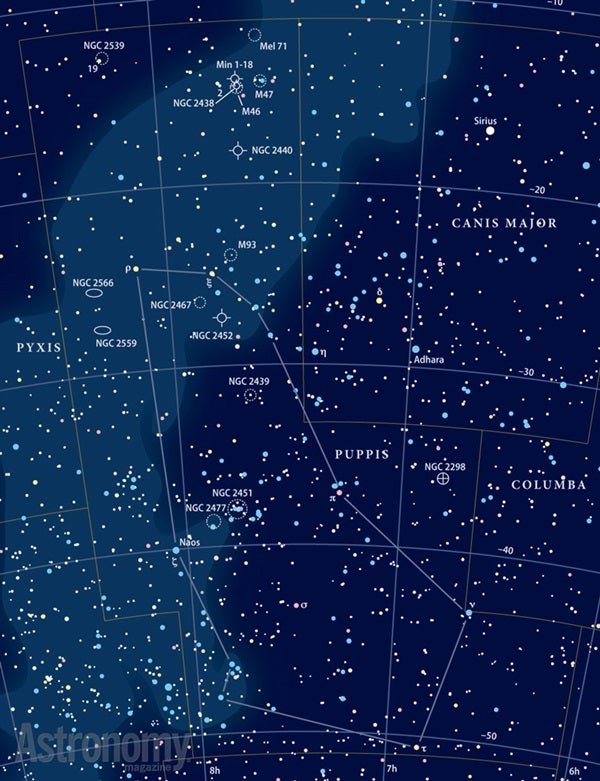Targets for February 19–26, 2015
Small telescope: Open cluster NGC 2421
Small telescope: Open cluster NGC 2477
Large telescope: Emission nebula Sharpless 2–311
This week’s first small-telescope target is open cluster NGC 2421 in Puppis. You’ll find it 5.2° northwest of magnitude 3.3 Xi (ξ) Puppis. It shines at magnitude 8.3 and measures 8′ across.
This rich object looks good through any size telescope, especially if you’re at or below latitude 25° north. That location will allow you to see it more than halfway up in the sky.
A 4-inch scope at 150x will show the cluster’s 30 brightest stars. Step up to a 10-inch instrument at 200x, and a new tier of stellar brightness appears.
In addition to the bright 30 you’ve already seen, another 30 slightly fainter stars tremble into view.
Fabulous cluster in Puppis
This week’s second small-scope object is another open cluster in Puppis, NGC 2477, also known as Caldwell 71. You’ll find this object 2.6° west-northwest of magnitude 2.2 Naos (Zeta [ζ] Puppis).
From a dark observing location, most of you will spot this magnitude 5.8 cluster with your naked eyes. It lies in a rich star field, however, so using averted vision really helps make it pop.
This is a spectacular target through any size telescope. Even a 4-inch instrument will reveal 60 or more stars. Most lie tightly packed near the center, and all have roughly equal brightnesses. Through a 12-inch scope, you’ll have to segment the cluster to count all its stars.
Segmenting involves counting the stars that lie within a pie-shaped region. You can divide the cluster into thirds, fourths, fifths, etc. You can also estimate the number if you count the stars that lie in the section of NGC 2477 that covers a clock’s face from noon to 3 o’clock. Then multiply by 4. What’s your tally? 150? 200? More?
This cluster is huge. With a diameter of 27′, it covers 76 percent as much sky as the Full Moon. Oh, and the magnitude 4.5 foreground star 20′ to the south-southeast is SAO 198545.
I’ll have the combo
This week’s large-telescope target lies 1.7° south-southeast of magnitude 3.3 Xi (ξ) Puppis, completing our triple play in that constellation this week. It’s a combination object that pairs open cluster NGC 2467 with emission nebula Sharpless 2–311.
The magnitude 7.1 cluster appears as little more than a spray of randomly distributed stars enveloped by gas. It’s not tiny. It spans 14′, which means it covers an area roughly 20 percent as large as the Full Moon. Just to the northwest of the nebula’s main mass is magnitude 9.4 Haffner 19, a tiny, separate cluster. But stars are not why you’re pointing your telescope here.
Through an 8-inch scope, use an eyepiece that gives a magnification of 150x and also insert an Oxygen-III filter. That will dim the stars, which will make Sh 2–311 stand out. Its high surface brightness will let you really crank up the magnification.
The bright central clump surrounding magnitude 7.8 SAO 174730 appears mottled with a hollow center and a bright southern rim. A 14-inch scope at 350x will reveal brightness differences along the face of the nebula, as well as several gaps and disassociated nebular regions.
Expand your observing at Astronomy.com
StarDome
Check out Astronomy.com’s interactive StarDome to see an accurate map of your sky. This tool will help you locate this week’s targets.
The Sky this Week
Get a daily digest of celestial events coming soon to a sky near you.
Observing Talk
After you listen to the podcast and try to find the objects, be sure to share your observing experience with us by leaving a comment at the blog or in the Reader Forums.











